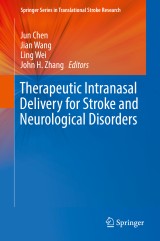Details

Therapeutic Intranasal Delivery for Stroke and Neurological Disorders
Springer Series in Translational Stroke Research
|
128,39 € |
|
| Verlag: | Springer |
| Format: | |
| Veröffentl.: | 03.06.2019 |
| ISBN/EAN: | 9783030167158 |
| Sprache: | englisch |
Dieses eBook enthält ein Wasserzeichen.
Beschreibungen
The blood-brain-barrier serves to encapsulate and protect the central nervous system, but it also presents a major barricade to therapeutic drug delivery. Poor penetration is the most common hurdle to translating a promising experimental therapy that uses invasive delivery methods to a clinically useful application. In the last 10 years, intranasal delivery of various therapeutic compounds including small chemicals, large proteins, and even stem cells has proven to be very effective in bypassing the blood-brain-barrier and has led to some important advances in translational research for stroke and other neurological diseases. The proposed book will bring together reports from various labs around the world who have had successes in pre-clinical studies of intranasal therapies for various diseases including adult and perinatal stroke, Alzheimer's, Parkinson's, and others.
<p>Preface.- Transnasal Induction of Therapeutic Hypothermia for Neuroprotection.- Hypoxia-Primed Stem Cell Transplantation in Stroke.- Therapeutic potential of intranasal drug delivery in preclinical studies of ischemic stroke and intracerebral hemorrhage.- Intranasal Drug Delivery after Intracerebral Hemorrhage.- Intranasal Treatment in Subarachnoid Hemorrhage.- Intranasal Delivery of Therapeutic Peptides for Treatment of Ischemic Brain Injury.- Intranasal delivering method in the treatment of ischemic stroke.- Intranasal Delivery of Drugs for Ischemic Stroke Treatment: Targeting IL-17A.- Intranasal tPA application for axonal remodeling in rodent stroke and traumatic brain injury models.- Therapeutic Intranasal Delivery for Alzheimer’s disease.- Combination therapy of intranasal IGF-1 and hypothermia.- Intranasal Medication Delivery in Children for Brain Disorders.- Index.</p>
<p>The blood-brain-barrier prevented harmful materials entering the brain and in the meantime is a barricade to therapeutic drug delivery. Intranasal drug delivery to circumvent blood-brain-barrier was developed in the past, to take advantages of a secret passage from the olfactory epithelium into the brain—bypassing the tight junctions that encapsulated the brain from blood circulation. This timely publication of Therapeutic Intranasal Delivery for Stroke and Neurological Disorders presented some of the latest advances in intranasal delivery research, including transnasal hypothermia induction, stem cell intranasal transplantation, intranasal drug delivery in ischemic and hemorrhagic models, intranasal peptides delivery, intranasal tPA application in adults and children. </p>Editors Jun Chen, Jian Wang, Ling Wei and John Zhang are professors from University of Pittsburgh, Johns Hopkins University, Emory University and Loma Linda University in USA.<br><p></p>
Comprehensive overview of studies of intranasal delivery Expected to have great impact on the field of translational stroke research Useful for researchers, physicians, and drug developers?

















